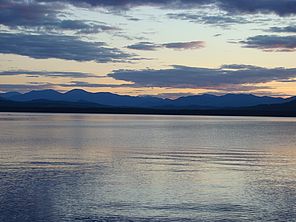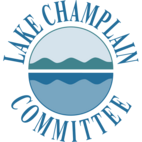EPA Releases New Champlain Pollution Budget
September 2015

On August 14th Governor Peter Shumlin and Curt Spaulding, Regional EPA administrator for New England, held a press conference in Burlington to announce the release of a revised pollution budget for Lake Champlain. The budget, known as at Total Maximum Daily Load or TMDL, has been in the works for four and a half years. It replaces a previously approved TMDL from 2002, which was challenged in court by the Conservation Law Foundation as being inadequate.
The TMDL allocates allowable phosphorus levels for different lake segments and pollution sources. Examples of lake segments include Missisquoi Bay, Burlington Bay, St. Albans Bay, and others. Examples of pollution sources include developed land, agriculture, wastewater treatment facilities, forestry, and eroding stream banks. The segment by segment approach allows different targets in different areas, so reductions in Burlington Bay will have to come from improved stormwater management, while those in Missisquoi Bay will have to come from changes in agricultural practices.
According to lake models, if Vermont can meet the pollution budget, Lake Champlain will meet its water quality standards and the frequency and intensity of blue-green algae blooms will decrease. However meeting the budget will require an approximate 34% reduction of phosphorus loading, something like 214 metric tons.
EPA has limited authority over which pollution sources it can regulate. They permit wastewater treatment facilities and industrial operations. They have some limited authority over the largest municipalities in the Lake Champlain Basin. But, they do not have authority to regulate most farm operations; that is left to the states. They have no authority over streambanks either. Yet farms, smaller developments, and streambank erosion account for the vast majority of pollution going to Lake Champlain. In other words, EPA had to allocate allowable pollution levels to land uses and practices over which they have no control. In order to do so, EPA needed to be convinced that Vermont had a reasonable plan for addressing these sources.
That is where the Vermont Legislatures passage of a Clean Water Bill last spring comes in. That bill calls for wide-ranging reforms on practices that affect water quality. It strengthens agricultural regulations, and calls for wider stream buffer zones, reduced allowable soil erosion from fields, and required livestock exclusion standards. It creates a program to prioritize and implement municipal road projects that affect our waters. It requires farmers that receive current use tax benefits to comply with water quality regulations. It establishes a clean water fund to carry out the provisions of the bill. It creates and funds 21 new position charged with protecting our waters: 8 in the Agency of Agriculture and 13 in the Agency of Natural Resources. It streamlines enforcement of agricultural regulations. It creates a self-certification program for small farms, and increases expected inspection frequency of all farms. It calls for development of practices to reduce pollution from tile drains. It creates a certification program and training for manure applicators. And it increases the role of Regional Planning Commissions in developing and implementing basin plans.
The passing of Vermont’s Clean Water Bill was sufficient to convince EPA that Vermont will make progress toward reducing pollution runoff.
Most of these reforms in the Clean Water Bill have yet to go into effect. The legislature passes the broad outline for state policy, but then leaves it to the Executive Branch to figure out how to implement those policies. The bill the legislature passed requires the Agencies of Natural Resources, Agriculture, and Transportation to write new rules, which they will then have to implement. The nitty grit ‘devil in the details’ work has just begun.
The plan offers no short term relief from algae blooms, nor could it. The conditions that allow blue-green algae to grow were not created in a short time frame and cannot simply be reversed. The state has not outlawed algae. At the best we are taking steps now that may one day reflect to the benefit of our grandchildren.
Notably absent from the new TMDL is any obligations on the part of New York. While the west coast of New England is forced to find ever more creative ways to reduce phosphorus, there’s no such pressure for the east coast of the Adirondacks. Each state is overseen by a different EPA region. While New York and Vermont jointly developed the original TMDL, only the Vermont portion was challenged in court so only the New England regional EPA office reopened the plan. That’s not to say New York isn’t doing anything, they will continue with the pollution reductions set forth in the original TMDL, however they have not been subject to the more intense scrutiny and oversight that has fallen on Vermont.
Vermont will soon have elections that change who’s in charge of implementing the Clean Water Bill. Governor Shumlin has announced he will not be running for re-election in 2016, and whoever replaces him is likely to replace a number of the agency heads as well. New agency heads will reflect the priorities of the new governor, which may or may not include clean water. It will be imperative for those concerned about Lake Champlain water quality to assure that the issue remains important for the next governor as well as this one.
Lake Look is a monthly natural history column produced by the Lake Champlain Committee (LCC). Formed in 1963, LCC is the only bi-state organization solely dedicated to protecting Lake Champlain’s health and accessibility. LCC uses science-based advocacy, education, and collaborative action to protect and restore water quality, safeguard natural habitats, foster stewardship, and ensure recreational access.
Get involved by joining LCC using our website secure form (at www.lakechamplaincommittee.org), or mail your contribution (Lake Champlain Committee, 208 Flynn Avenue - BLDG 3 - STUDIO 3-F, Burlington, VT 05401), or contact us at (802) 658-1414, or lcc@lakechamplaincommittee.org for more information.
